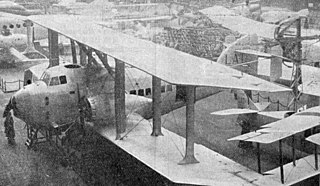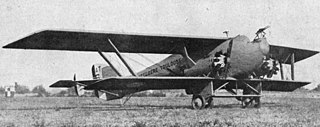
The Latécoère 28 was a long distance monoplane aircraft designed and produced by the French aircraft manufacturer Latécoère.

The Fiat BRG was an Italian heavy bomber prototype built in the 1930s by Fiat for the Italian Air Force.

The Farman F.70 was a 1920s French passenger and mail transport aircraft designed and built by the Farman Aviation Works. It was a smaller counterpart to the company's popular F.60 Goliath. The F.70 was an unequal-span two-bay biplane with a wooden fuselage and was powered by a Renault 12Fe piston engine. The pilot was seated in an open cockpit behind the nose-mounted engine. Behind the open cockpit was a cabin for four passengers or freight.

The PWS-20 was a Polish single-engine high-wing 8 passenger airliner, built in the PWS factory and when it made its first flight in 1929 it became the first Polish-designed transport aircraft to fly.
The Latécoère 14 and Latécoère 16 were similar French passenger and postal aircraft of advanced design built in 1923. They differed chiefly in engine power. Only one of each was constructed. The 14's type number was reused for an unrelated parasol wing prototype that was basis of the more successful Latécoère 17.

The Latécoère 17 was a French airliner built in 1923 for use on Latécoère's own airline routes between France and Morocco. The prototype was designated the Latécoère 14, reusing the number of an unrelated earlier design that had been rejected. This new aircraft was a parasol wing monoplane of conventional configuration with an enclosed cabin for four passengers and an open cockpit for the pilot. This was Latécoère's first commercially successful design and as production continued, three different engines were fitted.

The Latécoère 21 was a French flying boat built in 1925 for use by Lignes Aériennes Latécoère as an airliner on routes between France and North Africa. It was the first of the Latécoère flying boats, and the first aircraft to deliver mail between Marseilles and Algiers. It was a conventional design for the era, with a monoplane wing mounted parasol-fashion. Warren truss-style struts braced the wing to stub wings that acted as sponsons for stability while on the water. The twin engines were placed in tandem push-pull configuration on the wing. Up to seven passengers could be seated in an enclosed cabin, and two pilots sat side by side in separate open cockpits.
The Latécoère 570 was a twin-engined medium bomber designed to a 1934 specification. It did not fly until 1939, by which time competitor aircraft had gone into service.

The Latécoère 4 was a three-engined, 15-passenger biplane built in France in the early 1920s. It proved difficult to fly and was discontinued, though a second machine was completed as the Latécoère 5 bomber.

The Latécoère 6 was a French four-engined biplane bomber of the early 1920s. It was of advanced all-metal construction and probably the first aircraft to use geodetic construction. Only one was built.

The Latécoère 23 was a development of the Latécoère 21 flying boat, a twin-engined parasol winged aircraft. Only one was built, flying and crashing in late 1927. The similar Latécoère 32 was its immediate successor.
The Latécoère 340 was a three-engined, parasol winged flying boat designed in 1929 in France for middle-distance, overseas routes. The sole prototype was destroyed early in the testing programme, and no more were built.
The Latécoère 24 was a French three-engined parasol winged flying boat, built in 1927 to test the longer stretches of the South Atlantic crossing. Trials showed that it was overweight and consequently performed below specification.

The Latécoère 350 was a trimotor development of the Latécoère 28, a successful single-engined French monoplane of around 1930. The three engines were intended to provide the reliability needed for overnight flights, but the 350 came out very overweight. Only one was built.
The Latécoère 440 was a single-engined, high-winged float plane built as a coastal defence aircraft for the French Navy in the early 1930s. Two were produced to contract but did not impress in tests and the Navy chose instead the Latécoère 290.

The Latécoère 490 was a two-seat, single-engined parasol winged aircraft, designed to a French photographic reconnaissance specification of 1928. Only two prototypes were built.
The Latécoère 550 was a four-engined French seaplane, designed in the early 1930s as a bomber/torpedo bomber. Though initial handling problems were partly resolved, the aircraft was deemed too slow and did not go into production.

The Potez 35 was a twin engine bomber aircraft, designed and built in France in the late 1920s. Only one was completed.

The Caproni Ca.95 was a large, three engine, long range, heavy bomber prototype built in Italy in 1929. It could carry a 1,600 kg (3,500 lb) bomb load and had three defensive gun positions. Only one was built.
The CPA 1 was a French twin-engined, parasol-winged bomber designed and built in the mid-1920s.














